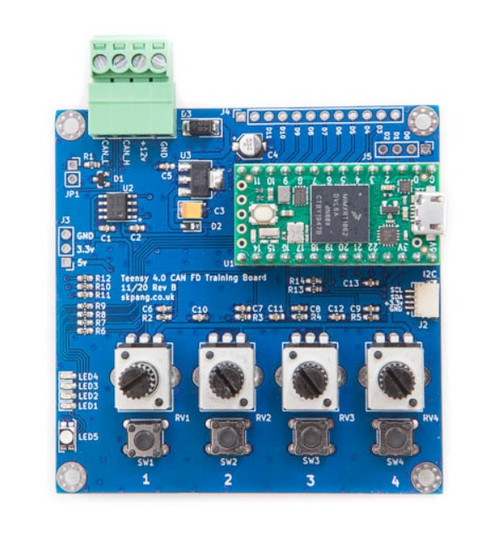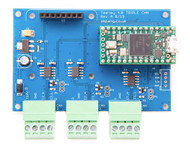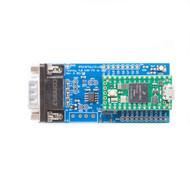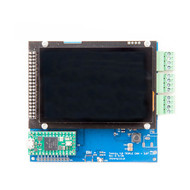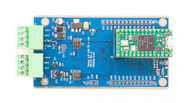Product Description
Free Shipping Within the United States!
Master Automotive and Industrial Communication with Confidence
Unlock the power of CAN protocols using a high-performance, hands-on learning and prototyping solution. The Teensy 4.0 CAN Bus & CAN FD Training Board is your bridge into the world of dynamic vehicle network design and embedded systems experimentation.
Why You’ll Love It
-
High-Speed, Compact Core: Powered by an Arduino-compatible Teensy 4.0, featuring an NXP i.MX RT1062 ARM Cortex‑M7 processor clocked at a blazing 600 MHz—renowned for speed, efficiency, and real-time performance.
-
Dual CAN Protocol Support: Effortlessly handle both Classical CAN (11-bit/29-bit IDs, up to 1 Mbps) and modern CAN FD (Flexible Data‑Rate with larger payloads, up to 8 Mbps). Ideal for exploring legacy systems and next-gen automotive communication.Built for Learning: Four onboard potentiometers simulate analog sensors, while multiple LEDs (including an RGB LED) and push‑buttons provide real-time feedback and control—perfect for educational demos and development.
-
Robust Power Design: Built-in voltage regulation (7–12 V input) and reverse‑voltage protection ensure reliable, abuse-resistant operation in lab or field settings.
-
Expandable with Ease: The integrated Qwiic (I²C) connector allows you to attach a wide range of external sensors, extending your project’s reach—from temperature and pressure sensors to accelerometers and beyond.
-
Fast and Flexible Learning: Prepping your development environment is a breeze with downloadable schematics, demo code, and installation guides provided by Copperhill Technologies.
Elevate Your Projects
Whether you're a student, hobbyist, or pro, this board is your gateway to mastering CAN communication:
-
Educational Tool: A must-have for hands-on learning—simulate sensor behavior, decode CAN frames, and explore protocol limits and error handling in real time.
-
Prototyping Powerhouse: Ideal for engineers crafting cutting-edge embedded systems in fields like automotive, robotics, and industrial automation.
-
Future-Ready Development: With both Classical CAN and CAN FD on hand, you’re ready for legacy systems and tomorrow’s intelligent, high-throughput networks.
-
Versatile Connectivity: Use Qwiic for modular sensor integration—great for building multi-domain test frames, data collectors, or intelligent gateways.
Specifications at a Glance
| Feature | Details |
|---|---|
| Core MCU | Teensy 4.0 (Cortex-M7, 600 MHz) |
| CAN Protocols | Classical CAN and CAN FD |
| Training Components | 4 potentiometers, smart LEDs (4 × red + 1 RGB), 4 push-buttons |
| Power | External 7–12 V DC input, includes voltage regulator & reverse-polarity protection |
| Expandable Interface | Qwiic (I²C) connector for external sensor modules |
| Support Materials | Schematics, demo software, documentation available |
Summary
The Teensy 4.0 CAN Bus & CAN FD Training Board is the ideal fusion of educational clarity and professional-grade capability. It marries the lightning-fast Teensy 4.0 microcontroller with versatile I/O simulation, dual CAN protocol support, and expandable sensor integration—all packaged in a rugged, user-friendly board.
Perfect for classrooms, workshops, and innovation labs, this board doesn’t just teach—you build, test, and iterate for real-world applications. Whether you’re learning about vehicle networks or developing next-gen automotive systems, this board puts powerful tools in your hands.
Ready to level up your embedded development?
Documents
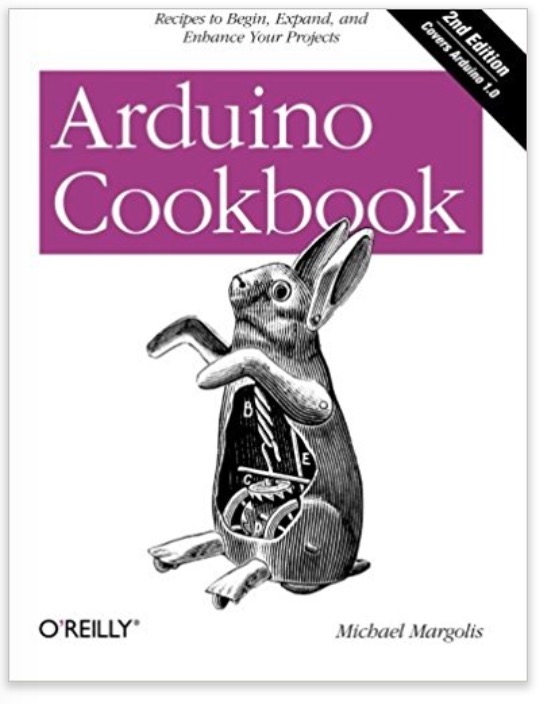 Arduino Cookbook
Arduino Cookbook
Want to create devices that interact with the physical world? This cookbook is perfect for anyone who wants to experiment with the popular Arduino microcontroller and programming environment. You will find more than 200 tips and techniques for building a variety of objects and prototypes such as toys, detectors, robots, and interactive clothing that can sense and respond to touch, sound, position, heat, and light.
You don't need experience with Arduino or programming to get started. Updated for the Arduino 1.0 release, the recipes in this second edition include practical examples and guidance to help you begin, expand, and enhance your projects right away, whether you are an artist, designer, hobbyist, student, or engineer.
- Get up to speed on the Arduino board and essential software concepts quickly
- Learn basic techniques for reading digital and analog signals
- Use Arduino with a variety of popular input devices and sensors
- Drive visual displays, generate sound, and control several types of motors
- Interact with devices that use remote controls, including TVs and appliances
- Learn techniques for handling time delays and time measurement
- Apply advanced coding and memory handling techniques
 Loading... Please wait...
Loading... Please wait...

